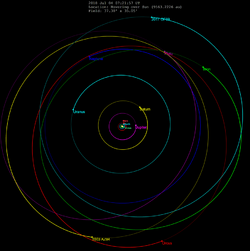Astronomy:2017 OF69
 | |
| Discovery[2][3] | |
|---|---|
| Discovered by | D. J. Tholen S. S. Sheppard[1] C. Trujillo |
| Discovery site | Mauna Kea Obs. |
| Discovery date | 26 July 2017 (first observed only) |
| Designations | |
| 2017 OF69 | |
| Minor planet category | TNO[4] · plutino[5] · distant[2] |
| Orbital characteristics[4] | |
| Epoch 27 April 2019 (JD 2458600.5) | |
| Uncertainty parameter 3 | |
| Observation arc | 6.01 yr (2,195 d) |
| |{{{apsis}}}|helion}} | 47.844 AU (7.1574 Tm) |
| |{{{apsis}}}|helion}} | 31.418 AU (4.7001 Tm) |
| 39.631 AU (5.9287 Tm) | |
| Eccentricity | 0.2072 |
| Orbital period | 249.49 yr (91,128 d) |
| Mean anomaly | 251.02° |
| Mean motion | 0° 0m 14.4s / day |
| Inclination | 13.654° |
| Longitude of ascending node | 218.53° |
| 215.37° | |
| Physical characteristics | |
| Mean diameter | 533 km (est.)[5] |
| Geometric albedo | 0.09 (assumed)[5] |
| Absolute magnitude (H) | 4.6[2][4] |
2017 OF69 is a resonant trans-Neptunian object from the Kuiper belt, located in the outermost region of the Solar System in the Kuiper belt's plutino population and measures approximately 533 kilometers (330 miles) in diameter. It was first observed on 26 July 2017, by American astronomers David Tholen, Scott Sheppard, and Chad Trujillo at Mauna Kea Observatories in Hawaii, but not announced until 31 May 2018 due to observations made in April and May 2018 refining its orbit significantly.[3]
Orbit and classification
2017 OF69 is a large plutino, a subgroup of the resonant trans-Neptunian objects located in the inner region of Kuiper belt. Named after the group's largest member, Pluto, the plutinos are making 2 orbits for every 3 Neptune makes.
It orbits the Sun at a distance of 31.4–47.8 AU once every 249 years and 6 months (91,128 days; semi-major axis of 39.63 AU). Its orbit has an eccentricity of 0.21 and an inclination of 14° with respect to the ecliptic.[4] The body's observation arc begins with a precovery by Pan-STARRS in June 2012.[2]
Numbering and naming
As of 2018, this minor planet has neither been numbered nor named by the Minor Planet Center. The official discoverer(s) will be defined when the object is numbered.[2]
Physical characteristics
Diameter and albedo
According to the Johnston's archive, 2017 OF69 measures 533 kilometers in diameter assuming an albedo of 0.09 for the body's surface.[5]
This makes 2017 OF69 a notably large body for how late it has been discovered, being the fifth largest plutino in the Solar System, after Pluto, Orcus, 2003 AZ84, and Ixion, and the largest discovered since Orcus in 2004. It is unknown exactly why no surveys had discovered it previously, as it is neither in a particularly dense region of the sky, nor far enough south that most northern hemisphere-based surveys would ignore it, being only 5–6° south of the celestial equator. It seems unlikely that any body as large as this one remains undetected in the plutino region.
Rotation period
As of 2018, no rotational lightcurve of 2017 OF69 has been obtained from photometric observations. The body's rotation period, pole and shape remain unknown.[4]
References
- ↑ "List Of Transneptunian Objects". Minor Planet Center. https://minorplanetcenter.net/iau/lists/TNOs.html. Retrieved 23 October 2018.
- ↑ 2.0 2.1 2.2 2.3 2.4 "2017 OF69". Minor Planet Center. https://www.minorplanetcenter.net/db_search/show_object?object_id=2017+OF69. Retrieved 23 October 2018.
- ↑ 3.0 3.1 "MPEC 2018-K109L 2017 OF69". International Astronomical Union. 31 May 2018. https://minorplanetcenter.net/mpec/K18/K18KA9.html. Retrieved 1 June 2018.
- ↑ 4.0 4.1 4.2 4.3 4.4 "JPL Small-Body Database Browser: (2017 OF69)". Jet Propulsion Laboratory. https://ssd.jpl.nasa.gov/sbdb.cgi?sstr=3825047. Retrieved 23 October 2018.
- ↑ 5.0 5.1 5.2 5.3 "List of Known Trans-Neptunian Objects". Johnston's Archive. 7 October 2018. http://www.johnstonsarchive.net/astro/tnoslist.html. Retrieved 23 October 2018.
External links
- List of Transneptunian Objects, Minor Planet Center
- 2017 OF69 at AstDyS-2, Asteroids—Dynamic Site
- 2017 OF69 at the JPL Small-Body Database
 |

